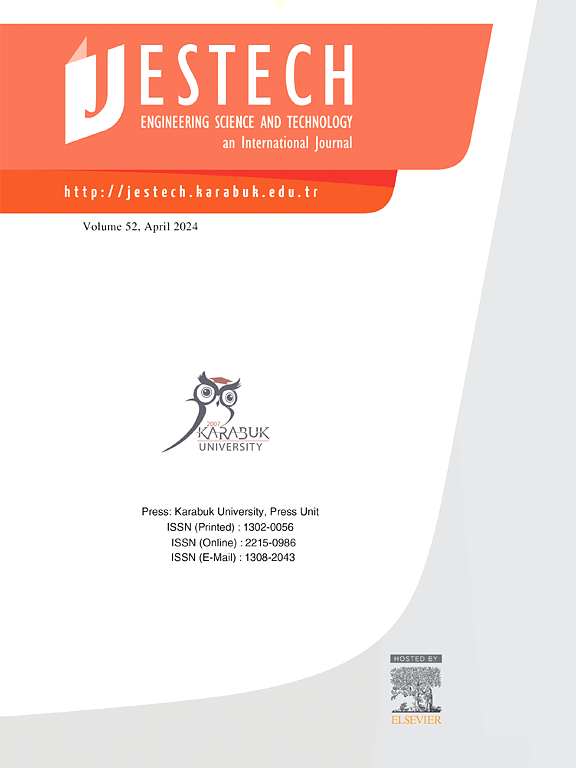GIS-based landslide susceptibility mapping using AHP, FMEA, and Pareto systematic analysis in central Yalova, Türkiye
IF 5.1
2区 工程技术
Q1 ENGINEERING, MULTIDISCIPLINARY
Engineering Science and Technology-An International Journal-Jestech
Pub Date : 2025-02-21
DOI:10.1016/j.jestch.2025.102013
引用次数: 0
Abstract
Yalova is a region with high landslide risk due to its climate, terrain, geographical features, and geological structure. Landslides in the region are of critical importance to produce landslide susceptibility maps and risk management because of the material and moral damage they cause. This study aimed to produce a Geographic Information System (GIS)-based landslide susceptibility map (LSM) of the Yalova central region using the Analytic Hierarchy Process (AHP), Failure Mode and Effect Analysis (FMEA), and Pareto systematic analyses. Lithology, slope, aspect, distance from roads, NDVI (Normalized Difference Vegetation Index), distance from faults, land use, rainfall, distance from rivers, and elevation factors were used in the analyses. The FMEA, Pareto, and AHP methods were used in an integrated and sequential manner to determine the LCF weights. According to the analysis, lithology was identified as the most influential factor, with the highest weight at 29.5%, while appearance had the lowest weight at 1.5%. The LSM was generated by processing the weight values in the prepared LCFs. Based on the produced landslide susceptibility map, the study area was categorized as having 29.60% very low-risk, 29.51% low-risk, 24.04% moderate-risk, 13.18% high-risk, and 3.68% very high-risk. Regional planning should be undertaken according to the landslide risk categories, and appropriate measures should be determined for each level in advance. Upon comparing the produced LSM with the existing inventory, it was determined that 95.29% of the previously occurring landslides in the region were in risky areas on the LSM. The results demonstrate the integrated applicability of the AHP, FMEA, and Pareto methods and provide a more accurate weighting of LCFs compared to a single method. The approach used in this study can be easily adapted to different regions and can be used not only for landslide analysis but also for risk assessment studies in other disciplines.
求助全文
约1分钟内获得全文
求助全文
来源期刊

Engineering Science and Technology-An International Journal-Jestech
Materials Science-Electronic, Optical and Magnetic Materials
CiteScore
11.20
自引率
3.50%
发文量
153
审稿时长
22 days
期刊介绍:
Engineering Science and Technology, an International Journal (JESTECH) (formerly Technology), a peer-reviewed quarterly engineering journal, publishes both theoretical and experimental high quality papers of permanent interest, not previously published in journals, in the field of engineering and applied science which aims to promote the theory and practice of technology and engineering. In addition to peer-reviewed original research papers, the Editorial Board welcomes original research reports, state-of-the-art reviews and communications in the broadly defined field of engineering science and technology.
The scope of JESTECH includes a wide spectrum of subjects including:
-Electrical/Electronics and Computer Engineering (Biomedical Engineering and Instrumentation; Coding, Cryptography, and Information Protection; Communications, Networks, Mobile Computing and Distributed Systems; Compilers and Operating Systems; Computer Architecture, Parallel Processing, and Dependability; Computer Vision and Robotics; Control Theory; Electromagnetic Waves, Microwave Techniques and Antennas; Embedded Systems; Integrated Circuits, VLSI Design, Testing, and CAD; Microelectromechanical Systems; Microelectronics, and Electronic Devices and Circuits; Power, Energy and Energy Conversion Systems; Signal, Image, and Speech Processing)
-Mechanical and Civil Engineering (Automotive Technologies; Biomechanics; Construction Materials; Design and Manufacturing; Dynamics and Control; Energy Generation, Utilization, Conversion, and Storage; Fluid Mechanics and Hydraulics; Heat and Mass Transfer; Micro-Nano Sciences; Renewable and Sustainable Energy Technologies; Robotics and Mechatronics; Solid Mechanics and Structure; Thermal Sciences)
-Metallurgical and Materials Engineering (Advanced Materials Science; Biomaterials; Ceramic and Inorgnanic Materials; Electronic-Magnetic Materials; Energy and Environment; Materials Characterizastion; Metallurgy; Polymers and Nanocomposites)
 求助内容:
求助内容: 应助结果提醒方式:
应助结果提醒方式:


